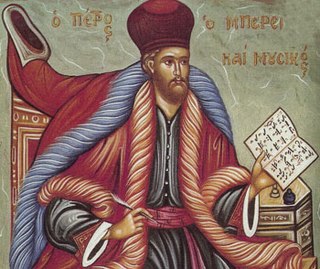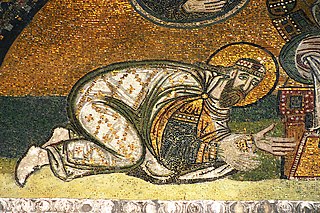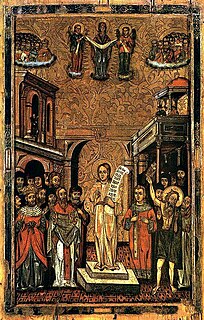 W
WAndrew of Crete, also known as Andrew of Jerusalem, was an 8th-century bishop, theologian, homilist, and hymnographer. He is venerated as a saint by Eastern Orthodoxy and the Catholic Church.
 W
WPetros Bereketis or Peter the Sweet was one of the most innovative musicians of 17th-century Constantinople. He, together with Panagiotes the New Chrysaphes, Balasios the Priest and Germanos Bishop of New Patras was one of the most influential figures in the evolution of the Byzantine psaltic art following the fall of Constantinople in 1453, although he never was associated with the Patriarchate in Fener. For many years, he served as the protopsaltis of church St. Constantine of the Hypsomatheia district close to the Marmara coast.
 W
WJohn of Damascus, also known as John Damascene and as Chrysorrhoas, was a Christian monk, priest, and apologist. Born and raised in Damascus c. 675 or 676, he died at his monastery, Mar Saba, near Jerusalem on 4 December 749.
 W
WSaint Joseph the Hymnographer was a Greek monk of the ninth century. He is one of the greatest liturgical poets and hymnographers of the Eastern Orthodox Church, but as a poet he is often confused with Joseph, the Archbishop of Thessalonica and brother of Theodore the Studite, who were one generation older than he was. He is also known for his confession of the Orthodox Faith in opposition to Iconoclasm. He is called in certain sources "the sweet-voiced nightingale of the Church".
 W
WKassia, Cassia or Kassiani was a Byzantine abbess, poet, composer, and hymnographer. She is one of the first medieval composers whose scores are both extant and able to be interpreted by modern scholars and musicians. Approximately fifty of her hymns are extant and twenty-three are included in Orthodox Church liturgical books. The exact number is difficult to assess, as many hymns are ascribed to different authors in different manuscripts and are often identified as anonymous.
 W
WJohn Koukouzelis or Jan Kukuzeli was a Byzantine medieval Orthodox Christian composer, singer and reformer of Eastern Orthodox music. He was recognized as a saint by the Eastern Orthodox Church after his death. His music is held in high esteem by Albanians, Bulgarians, Greeks, Macedonians, Romanians and Serbs.
 W
WLeo VI, called the Wise or the Philosopher, was Byzantine Emperor from 886 to 912. The second ruler of the Macedonian dynasty, he was very well-read, leading to his epithet. During his reign, the renaissance of letters, begun by his predecessor Basil I, continued; but the Empire also saw several military defeats in the Balkans against Bulgaria and against the Arabs in Sicily and the Aegean. His reign also witnessed the formal discontinuation of several ancient Roman institutions, such as the separate office of Roman consul.
 W
WSaint Romanos the Melodist or the Hymnographer was a notable Syrio-Greek hymnographer, called "the Pindar of rhythmic poetry". He flourished during the sixth century, which is considered to be the "Golden Age" of Byzantine hymnography.
 W
WTheodore the Studite was a Byzantine Greek monk and abbot of the Stoudios Monastery in Constantinople. He played a major role in the revivals both of Byzantine monasticism and of classical literary genres in Byzantium. He is known as a zealous opponent of iconoclasm, one of several conflicts that set him at odds with both emperor and patriarch.